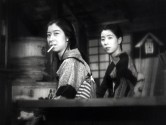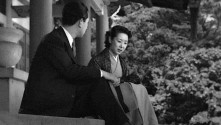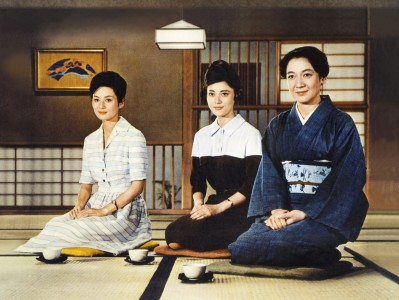
With Early Spring, Ozu aimed to portray what he described as “the pathos of white-collar life.” The title refers to the wistful period of young adulthood in which his characters find themselves. Jaded by his job and bored with his marriage to Masako (Awashima Chikage), office worker Shoji (Ikebe Ryo) has an affair with his coworker Chiyo (Kishi Keiko). Ozu portrays Shoji and Chiyo’s affair with only a few objects and gestures—robes, bottles, a kiss concealed by backs turned to the camera. Despite being somewhat understated in its depiction of sex, Early Spring’s plot is reflective of young audiences’ and studios’ growing demand for more explicit films during the mid-1950s. Yet the film, one of Ozu’s longest, treats its subject matter with a measured distance. The sexual encounter occurs and recedes into memory relatively early. The narrative then continues as a series of conversations (with neighbors, family members, army friends, and coworkers) regarding the incident; all the while the banality of Shoji’s work continues to wear him down. That lust is the careless outgrowth of burnout is one of Ozu’s strongest insights about the disintegration of work-life balance, which takes with it the remainder of one’s youth.
Part of film series
Screenings from this program
Late Spring

Tokyo Story

Early Summer

Passing Fancy

Dragnet Girl

Tokyo Story

A Story of Floating Weeds

Days of Youth

The Flavor of Green Tea over Rice

Early Spring

The Munekata Sisters

Floating Weeds

Good Morning

Late Autumn

Tokyo Twilight

The Brothers and Sisters of the Toda Family

I Flunked, But …

Late Autumn

Where Now Are the Dreams of Youth?

The End of Summer

Early Spring

Café Lumière

Tokyo Story





















